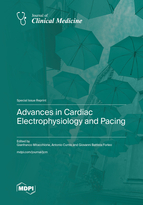Advances in Cardiac Electrophysiology and Pacing
A special issue of Journal of Clinical Medicine (ISSN 2077-0383). This special issue belongs to the section "Cardiovascular Medicine".
Deadline for manuscript submissions: closed (30 June 2023) | Viewed by 16624
Special Issue Editors
Interests: catheter ablation; implantable cardioverter defibrillator (ICD); subcutaneous implantable cardioverter defibrillator (S-ICD); cardiac pacing; leadless pacemaker; transseptal catheterization; atrial fibrillation ablation; cardiac resynchronization therapy (CRT); lead extraction
Special Issues, Collections and Topics in MDPI journals
Interests: cardiac pacing; lead extraction; atrial fibrillation ablation; cardiac resynchronization therapy (CRT); cardiac arrhythmias; leadless pacemaker; catheter ablation; implantable cardioverter defibrillators (ICD); subcutaneous implantable cardioverter defibrillator (S-ICD)
Interests: ventricular tachycardia ablation; atrial fibrillation ablation; cardiac pacing; cardiac resynchronization therapy (CRTD); implantable cardioverter defibrillators; lead extraction; subcutaneous implantable cardioverter defibrillator (S-ICD)
Special Issues, Collections and Topics in MDPI journals
Special Issue Information
Dear Colleagues,
Today, interventional treatment of cardiac arrhythmias represents a continuous challenge. This is mainly due to the widening of indications for implantable electronic devices (CIEDs) and for catheter ablation (CA), as well as to the continuous improvement of the technologies. Despite international guidelines and worldwide consensus updates, evidence gaps persist at all points. The aim of this Special Issue is to provide a comprehensive overview of advances in the diagnosis and treatment of cardiac arrhythmias, with particular interest in the use of innovative techniques and technologies in interventional therapies. Therefore, researchers in the field of clinical arrhythmology and electrophysiology are encouraged to submit their findings as original articles or reviews to this Special Issue.
Dr. Gianfranco Mitacchione
Prof. Dr. Antonio Curnis
Prof. Dr. Giovanni Battista Forleo
Guest Editors
Manuscript Submission Information
Manuscripts should be submitted online at www.mdpi.com by registering and logging in to this website. Once you are registered, click here to go to the submission form. Manuscripts can be submitted until the deadline. All submissions that pass pre-check are peer-reviewed. Accepted papers will be published continuously in the journal (as soon as accepted) and will be listed together on the special issue website. Research articles, review articles as well as short communications are invited. For planned papers, a title and short abstract (about 100 words) can be sent to the Editorial Office for announcement on this website.
Submitted manuscripts should not have been published previously, nor be under consideration for publication elsewhere (except conference proceedings papers). All manuscripts are thoroughly refereed through a single-blind peer-review process. A guide for authors and other relevant information for submission of manuscripts is available on the Instructions for Authors page. Journal of Clinical Medicine is an international peer-reviewed open access semimonthly journal published by MDPI.
Please visit the Instructions for Authors page before submitting a manuscript. The Article Processing Charge (APC) for publication in this open access journal is 2600 CHF (Swiss Francs). Submitted papers should be well formatted and use good English. Authors may use MDPI's English editing service prior to publication or during author revisions.
Keywords
- cardiac arrhythmias
- cardiac implantable electronic device
- catheter ablation
- sudden cardiac death
- lead extraction
- atrial fibrillation
- ventricular tachycardia
- defibrillator therapy








